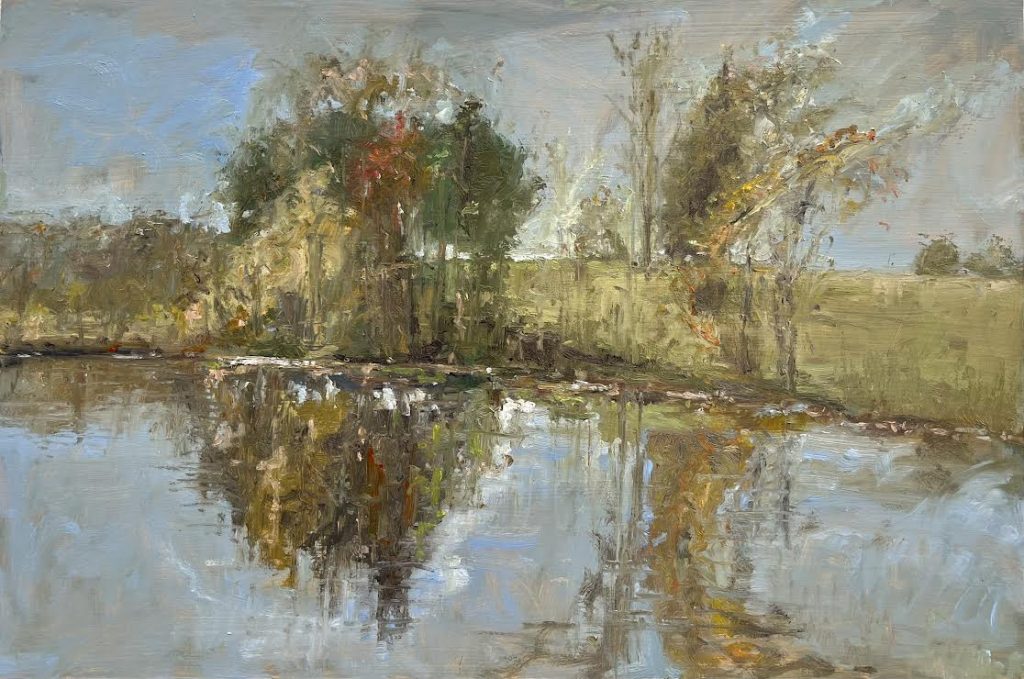The Barn Swallow Artisan Gallery 796 Gillums Ridge Rd. “Listening to Artifacts,” new works in sculpture and collage by Kim Boggs. Through July 7. First Fridays reception at 5:30pm.

Chroma Projects Inside Vault Virginia, Third St. SE. “Bellair: Making Visible the Invisible,” plein air landscape paintings of a local farm over the course of a year by Raymond Berry. Through August. First Fridays reception at 5pm.
City Clay 700 Harris Street, Ste. 104. “Emma’s Imaginarium,” a large-scale coralscape installation of ceramic works by Emma Terry. Through July 25.
Crozet Artisan Depot 5791 Three Notch’d Rd., Crozet. “A Lasting Impression,” functional ceramic works by Ingrid Chase. “The Unfolding of your Words,” plein air paintings by Donna Cruce Kocka. Through July. Meet the artist event July 13, 11am–1pm.
C’ville Arts Cooperative Gallery 118 E. Main St., Downtown Mall. “Dreaming of Trees,” by Mary Ellen Larkins explores the inspiring and magical aspects of fused glass. Through July. First Fridays reception at 5pm.
Dovetail Design and Cabinetry 1740 Broadway St., Suite 3. “TWEETS,” acrylic and watercolor works by Matalie Deane and Juliette Swenson. Through July.
The Fralin Museum of Art at UVA 155 Rugby Rd. “Madayin: Eight Decades of Aboriginal Australian Bark Painting from Yirrkala.” Through July 14. “The Spaces We Seek,” curated by students from the 2023–24 University Museums Internship class. Through July 14. “Barbara Hammer: Evidentiary Bodies,” featuring an immersive multichannel video installation. June 22, 2024–January 26, 2025. The museum will be closed July 15–August 30 for exhibition changeover.
Ix Art Park 522 2nd St. SE. “The Jungle Within,” a new exhibition featuring living plants by Annie Temmink with Trevor Kemp inside “The Looking Glass.” Ongoing. “Art Mix at Ix,” a fun night of painting, live music, and cocktails at the outdoor art park. Paint Swap Party, a painting workshop where artists switch canvases every 5 minutes. First Fridays, 6:30pm.

Kluge-Ruhe Aboriginal Art Collection of UVA 400 Worrell Dr. “Shifting Ground: Prints by Indigenous Australian Artists from the Basil Hall Editions Workshop Proofs Collection,” curated by Jessyca Hutchens, featuring work by 22 Indigenous Australian artists. Through October 6. “Our Unbroken Line: The Griffiths Family,” screenprints on textiles, ceramic works, and paintings curated by Dora Griffiths. July 13–December 8.
Les Yeux du Monde 841 Wolf Trap Rd. “Influence + Conversation,” interdisciplinary works by Barbara Campbell Thomas and Isabelle Abbot. July 12–August 25. Opening reception July 12 from 5–7pm.
McGuffey Art Center 201 Second St. NW. In the Smith, First, and Second Floor Galleries, the annual “All Members Summer Show,” features current work from renting and associate members. July 2–August 18. In the Lower Level North Gallery, “International Neighbors Exhibition,” featuring artworks made by refugees resettled in Charlottesville. Through July. First Fridays reception at 5:30pm.
New City Arts 114 Third St. NE. In the Welcome Gallery, “Around the Table: Political play, agency, gamification, and other things we can learn from board games,” a multidimensional exploration of the art and politics of board games, curated by New City Arts Artist-in-Residence Chandler Jennings. July 12–25. Opening reception July 12 at 5pm.
The PVCC Gallery V. Earl Dickinson Building, 501 College Dr. The 2024 Student Art Exhibition, celebrating the accomplishments of student artists from the latest academic year. Through September 7.

Quirk Gallery 499 W. Main St. In “Care Less,” artist Seth Bauserman borrows the subject matter of his daughter’s drawings to explore the space between innocence and experience. Through July 28.
Random Row Brewing Co. 608 Preston Ave. “Inside/Outside: Flowers in the Window,” recent paintings by Randy Baskerville. Through August.
The Rotunda UVA Grounds. In the Upper West Oval Room, the Charlottesville Indigenous Art Takeover. “Waŋupini: Clouds Of Remembrance And Return,” works featuring depictions of clouds by various artists. Through July 7.

Second Street Gallery 115 Second St. SE. In the Main Gallery, “The Art of Collage” features artworks from 41 contemporary artists. In the Dové Gallery, “Paper Room,” a mixed-media and interactive exhibition by Jess Walters with Stephen Haske and Sarah Lawson. Through July 19.
Studio Ix 969 2nd St. SE. “More Echo,” features new works by Thomas Dean, including screenprints on paper and wood and collage images. July 5–September 1. Opening reception July 12 at 5pm.
Visible Records 1740 Broadway St. “Amigxs Gringxs,” a group exhibition featuring artists of many diasporas looking at their complex relationships with immigration/migration, colonization, cultural heritage, and trans-border/cultural identities. Through August 2.
Images courtesy of the galleries and/or artists.


























